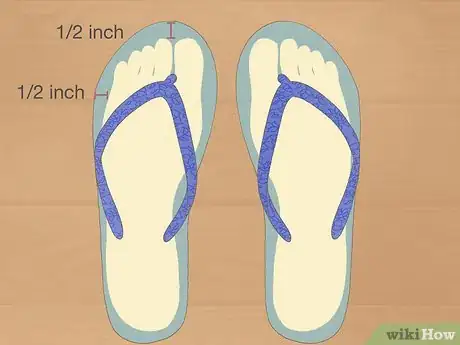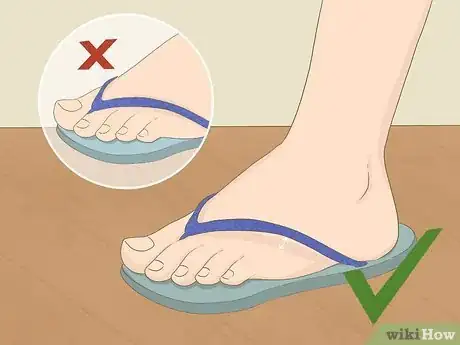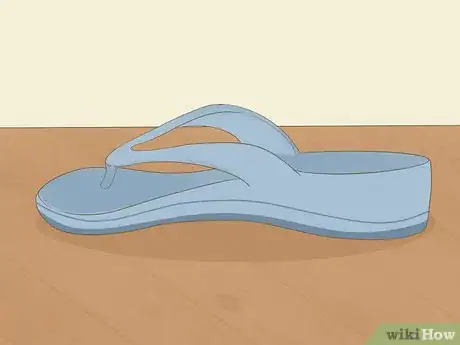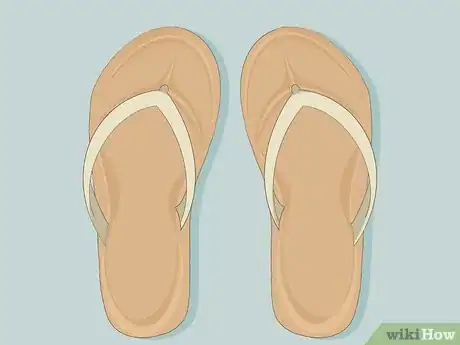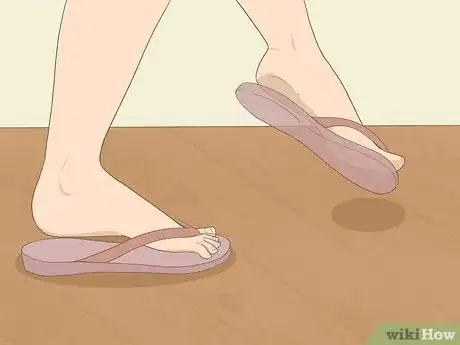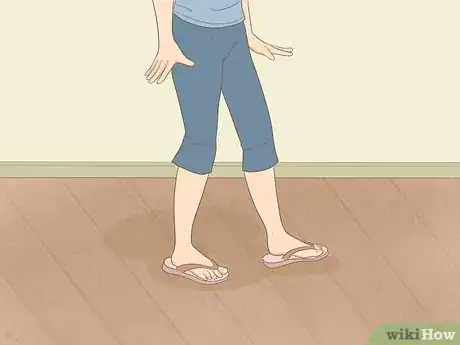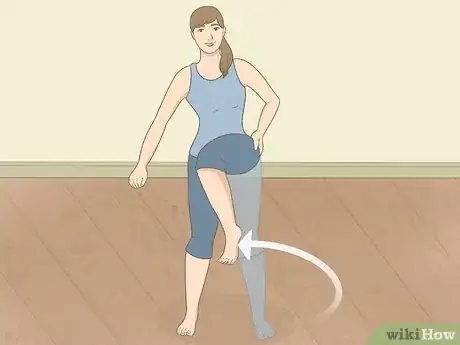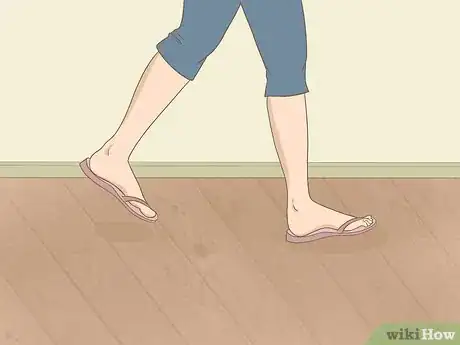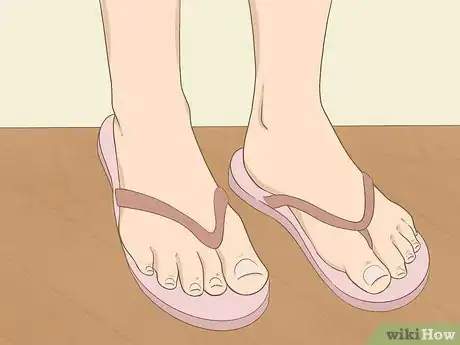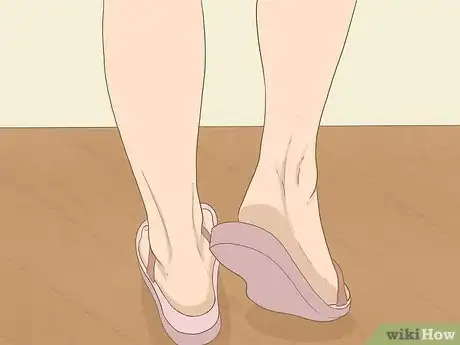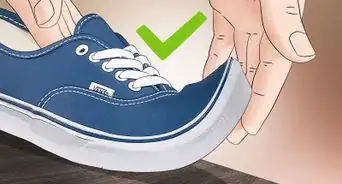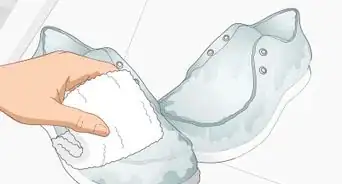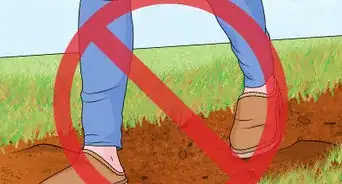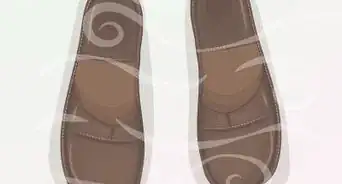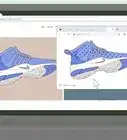This article was co-authored by Miguel Cunha, DPM. Dr. Miguel Cunha is the founder of Gotham Footcare and is a podiatrist based in Manhattan, New York. Dr. Cunha is a foot and ankle surgeon with experience treating a wide array of foot and ankle conditions from minor problems to complex reconstructive foot and ankle surgery. Dr. Cunha received his DPM from the Temple University School of Podiatric Medicine and completed his residency as the Chief Resident at the Washington Hospital Center and Georgetown University where he specialized in lower extremity trauma, diabetic limb salvage, and reconstructive surgery of the foot and ankle. Dr. Cunha is a member of the American Podiatric Medical Association, the New York Podiatric Medical Association, the American College of Foot and Ankle Surgeons, and is board certified in Podiatric Medicine.
There are 7 references cited in this article, which can be found at the bottom of the page.
This article has been viewed 170,617 times.
Flip flops are perfect if you’re going to the beach or just taking a leisurely summer stroll. Buying flip flops that fit correctly is key to keep your feet healthy and blister-free. It’s important to choose a footbed best suited for the activities you plan to do in your flip flops. You’ll also need to mind how you walk in your flip flops to avoid injuring your feet, legs, and hips over time.
Steps
Buying Flip Flops
-
1Check for 1⁄2 inch (1.3 cm) of room around your foot when you try them on. When standing in them you should be able to see about a 1⁄2 inch (1.3 cm) of the footbed all around your foot. If you try them on and your toes or heels hang over the edges, go up a size.
- Check for the 1⁄2 inch (1.3 cm) of room while standing still and walking around because your foot might shift as you walk.
-
2Make sure the straps are a good fit and don’t rub the top of your feet. If the straps are leather or cloth, make sure it’s a snug fit. Flip flops with rubber straps can be less irritating to the skin on your feet but make sure the material isn’t too tight or too loose in certain places.[1]
- Tight rubber straps might cut into your skin over time and loose rubber straps might cause irritation friction.
Advertisement -
3Choose a flip flop with a thick sole and good arch support. Flip flops aren’t typically the most supportive shoes—most of the time they’re intended for convenience. Try to find a well-padded flip flop that has a thicker sole near where the middle part of your foot rests (the arch).
- If you can feel your heel hitting the hard ground when you walk, that’s a sign of a thin sole. Too much walking in a thin flip flop will eventually cause your feet to be sore.
- Light foam footbeds might seem like a cheap, easy option, but this material provides little to no support. Over time, wearing flip flops like this can cause plantar fasciitis (painful inflammation near the heel of your foot).
- Try bending the flip flop with your hands to test its stability. Too much bend near the center of the footbed means it provides little stability.
-
4Opt for foot-molding footbeds for increased comfort and support. Flip flops that have foot-molding footbeds will gradually change their form to fit the shape of your foot. They’re a good choice if you’ll be doing a lot of walking because they usually provide good support and shock absorption.[2]
- Note that if you currently have foot problems like pronation or supination (that is, your weight rolling either to the inside or outside of your foot), foot-molding footbeds might exacerbate the problem.
-
5Opt for contoured footbeds for the most stability and support. If you’re going to be wearing your flip flops every day or doing lots of walking, contoured footbeds are the way to go. They’ll give you the most stability and arch support. Some are even molded to be orthopedic and will help correct any mild abnormalities in your foot muscles.[3]
- Try on different pairs of contoured flip flops as the heel cups (the back part cradling your heel), toe boxes (the front part holding your toes), and arch height can vary from model to model.
- Note that contoured flip-flops can be pricey, but it may be worth it for the health of your feet! Plus, they’ll probably last a lot longer than foam-soled flip flops.
Walking in Flip Flops
-
1When walking, keep your feet pointed as straight as you can. If you walk with your feet turned inward (“pigeon-toed”) or outward (“duck-footed”), your flip flops might get caught on the ground or each other and cause you to trip. Walking either one of these ways can also cause foot abnormalities and other issues over time.[4]
- If you naturally walk pigeon-toed or duck-footed, you can correct your gait by doing hip and leg rotation exercises.
-
2Do penguin walks to help correct pigeon toeing. Stand upright with your feet turned outward. Shift your weight onto your heels and walk about 20 to 30 paces. Do about 3 or 4 sets of 20 paces at least once a day for the best results.[5]
- This simple exercise will help your hips’ external rotation—internally rotated hips are a common cause of pigeon toes.
-
3Correct duck-feet with a hip rotation stretch. Stand upright with your right leg raised in front of you. Lock your knee and flex your feet so your toes are pulled back. Then, rotate your right hip toward your center (so your raised toes are pointing to the left). Return to the starting position to make 1 rep.[6]
- Do this simple move 10 to 12 times on each leg at least once a day.
-
4Keep your strides natural or a little shorter, if necessary. Taking large steps can put pressure on your hip flexors and, over time, this can lead to strains and lower back pain. Your gait might be a little shorter while you’re wearing flip flops because taking smaller steps helps keep them on. It’s better to go with what feels natural than to try to overcompensate by taking larger steps.[7]
- Taking smaller strides also helps absorb some of the shock when you step.
- Over-striding might can also cause sore heels and lead to plantar fasciitis over time.
-
5Pinch your big toe and pointer toe together as you walk. Slightly squeezing these two toes together will help you to keep control of the position of the flip-flop on your foot, lessening the chance that you might trip. This is especially important if your flip flops don’t have a thong or toe hold.
- You don’t have to actively try to do this as it should just come naturally. If your flip flop comes off even if you’re pinching your big toe and second toe together, that’s a sign that you need to go down a size.
-
6Curl your toes slightly to grip the flip flop. Curling your toes just slightly can help you keep your balance and grip on the flip flop. However, avoid over-curling your toes because doing so can cause hammer toes and lead to corns, calluses, and foot pain.[8]
- As your foot is directly under your body, your toes will naturally curl as if to grip the ground. Then, once your foot passes behind your body, your toes straighten again in order to propel you forward while keeping your balance.
-
7Walk heel to toe to keep your legs and hips pain-free. Walk in flip flops as if you were barefoot. Avoid scuffling along flat-footed because doing so can lead to hip and leg issues over time. If your flip flops fit correctly, there should be no need to continuously scuff or slide your feet to keep them on.[9]
- Touch the ground with the fleshy part of your heel first, then roll your foot downward onto the ground so the outside of the arch will make contact before the ball of your foot and toes.
- The flip flop should hit the heel of your back foot as you lift it off the ground to bring it forward again (hence the name “flip flop”).
Community Q&A
-
QuestionHow can I walk so that they don't make that "flip flop" noise?
 Kiera MaehlingCommunity AnswerFlip-flops were made specifically to make that noise, your best bet would probably be to just buy sandals instead. There is really no way to stop the noise that flip-flops make, so you're out of luck.
Kiera MaehlingCommunity AnswerFlip-flops were made specifically to make that noise, your best bet would probably be to just buy sandals instead. There is really no way to stop the noise that flip-flops make, so you're out of luck. -
QuestionI have thong sandals with straps but sometimes my foot will slide to the side. It seems I need Velcro on the bottom of my foot and sandal so it won't move. Is there a product out there for this?
 Community AnswerYou can use double-sided tape.
Community AnswerYou can use double-sided tape.
Warnings
- Be careful about driving in flip flops because they can get stuck under the panel just above the pedals (especially if you tend to place your foot high up on the pedals).⧼thumbs_response⧽
- Be careful wearing flip flops that are wet. The soles and footbeds can become very slippery and cause you to trip or lose your balance.⧼thumbs_response⧽
References
- ↑ https://www.outdoorgearlab.com/topics/shoes-and-boots/best-flip-flops-womens/buying-advice
- ↑ https://www.outdoorgearlab.com/topics/shoes-and-boots/best-flip-flops-womens/buying-advice
- ↑ https://www.outdoorgearlab.com/topics/shoes-and-boots/best-flip-flops-womens/buying-advice
- ↑ https://www.betterhealth.vic.gov.au/health/healthyliving/childrens-feet-and-shoes
- ↑ https://youtu.be/c1-bTyUFD5g?t=280
- ↑ https://physicalliving.com/4-exercises-to-fix-duck-feet-by-improving-hip-internal-rotation/
- ↑ https://www.racgp.org.au/afp/2014/april/hip-pain-in-young-adults/
- ↑ https://www.health.harvard.edu/newsletter_article/By-the-way-doctor-Flip-flops---how-bad-are-they
- ↑ https://footeducation.com/biomechanics-of-walking-gait/
About This Article
Flip flops can be super comfortable, but only if you choose the right size. When you're shopping for flip flops, make sure you have about 1/2 inch of room all around your foot when you try them on. The straps should also fit snugly over your feet, but not rub against them. Since flip flops lack the support you get from other footwear on the sides of your feet, try to pick a pair that have arches in the middle for comfort. When you walk in your flip flops, keep your feet pointing straight so your flip flops don’t catch in the ground. You should also take slightly shorter steps, which will reduce the pressure on your hips. For tips on how to correct duck feet or pigeon toe while wearing flip flops, keep reading!
